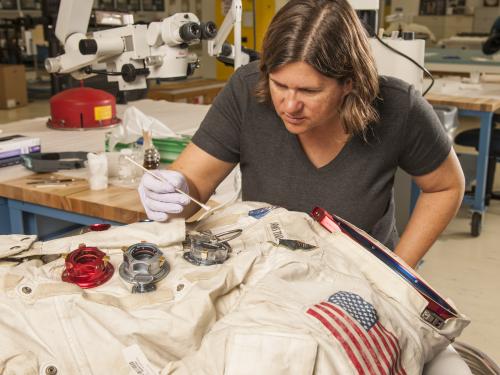

Stories of daring, stories of technological feats, stories of prevailing against the odds ... these are the stories we tell at the National Air and Space Museum. Dive in to the stories below to discover, learn, and be inspired.
Showing 71 - 80 of 176

July 16, 2019
Before returning Neil Armstrong's Apollo 11 spacesuit to display in time for the 50th anniversary of the Apollo 11 mission, it underwent extensive conservation and a state-of-the-art display case and mannequin was designed to protect it while on display.

July 16, 2019
Working with the museum, the Smithsonian's Digitization Program Office 3D scanned Neil Armstrong's spacesuit, helmet, and gloves. The resulting 3D models, which have been fully annotated by the suit’s curator and conservator, are now available.

July 15, 2019

July 12, 2019
From an outsider’s perspective, Lamar Dodd must have seemed like an unlikely choice for a commission to create paintings on the subject of space. Dodd was in the first group recruited for the NASA Art Program, which tasked artists with translating the cultural and scientific monumentality of the space missions to a national audience.

July 11, 2019
In part two of Walking on the Moon, we’re talking about the important science still happening with Apollo Moon rocks here on Earth a half-century later.

July 11, 2019
On July 11, 1969 – only 5 days before Neil Armstrong, Michael Collins, and Buzz Aldrin set out on their journey to the Moon – a relatively unknown British musician named David Bowie released a single titled Space Oddity.

July 10, 2019
When early astronauts traveled into space, and in this case, the Moon, lives depended on communications equipment that kept them in contact at all times with those stationed on Earth, like this "Snoopy Cap" communications carrier.

July 09, 2019
The NASA Art Program played an important role in representing the excitement and public interest in early spaceflight missions like Apollo 11. As we look back at key moments from the historic missions, we do so not only through photographs and oral histories, but through the eyes of artists as well.

July 08, 2019
As we approach the 50th anniversary of humankind’s first steps on the Moon, our ability to reflect on those events is thanks in part to how the moment was shared with people around the world. The Apollo 11 mission was not the first time television signals returned from the orbit of the Moon, but the landing in July 1969 was by far the most important to get just right.

July 05, 2019
"When I was a kid – maybe 5 or 6 – I remember my dad calling me into the living room and sitting me down in front of our almost comically tiny black-and-white TV screen."